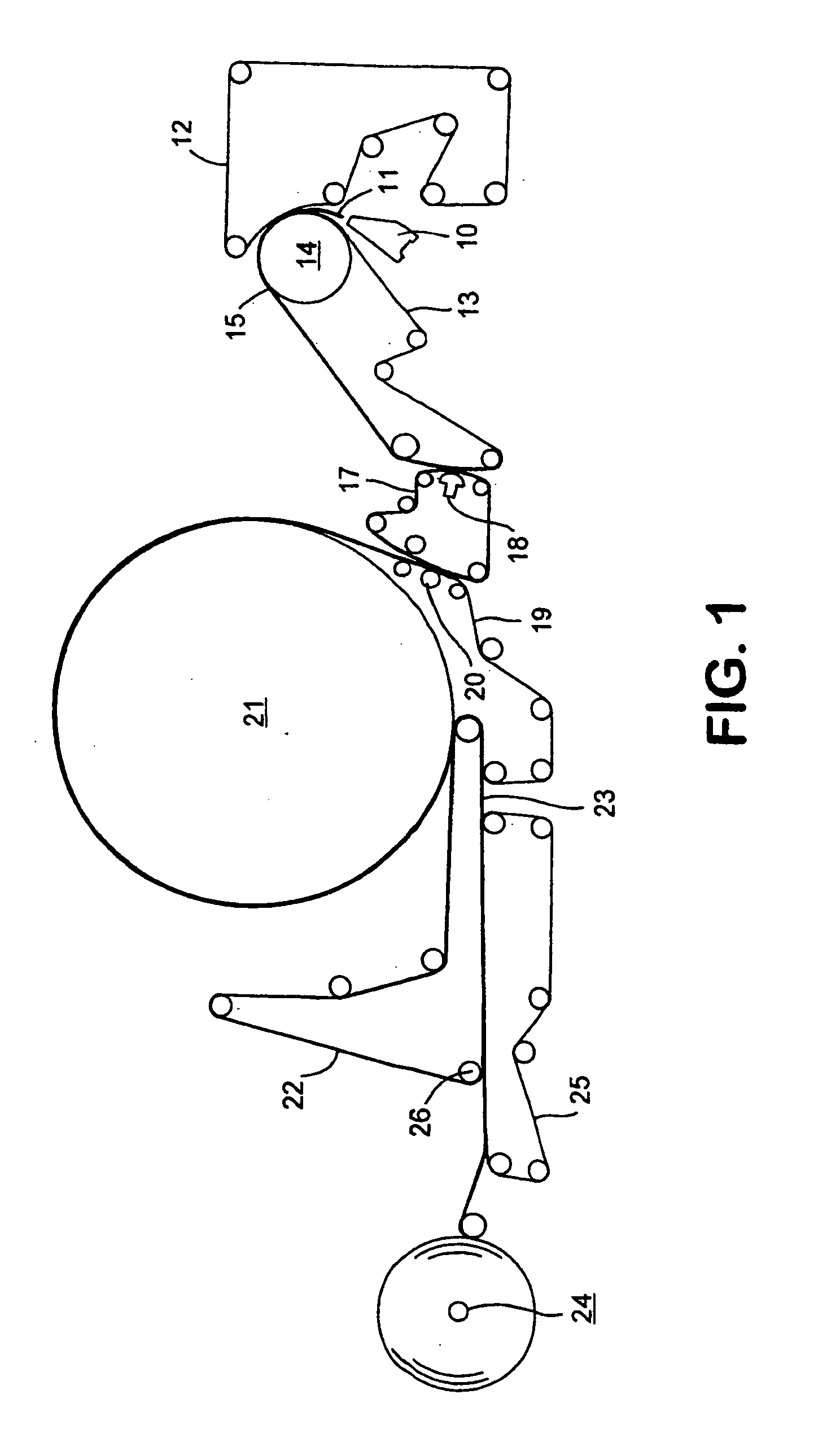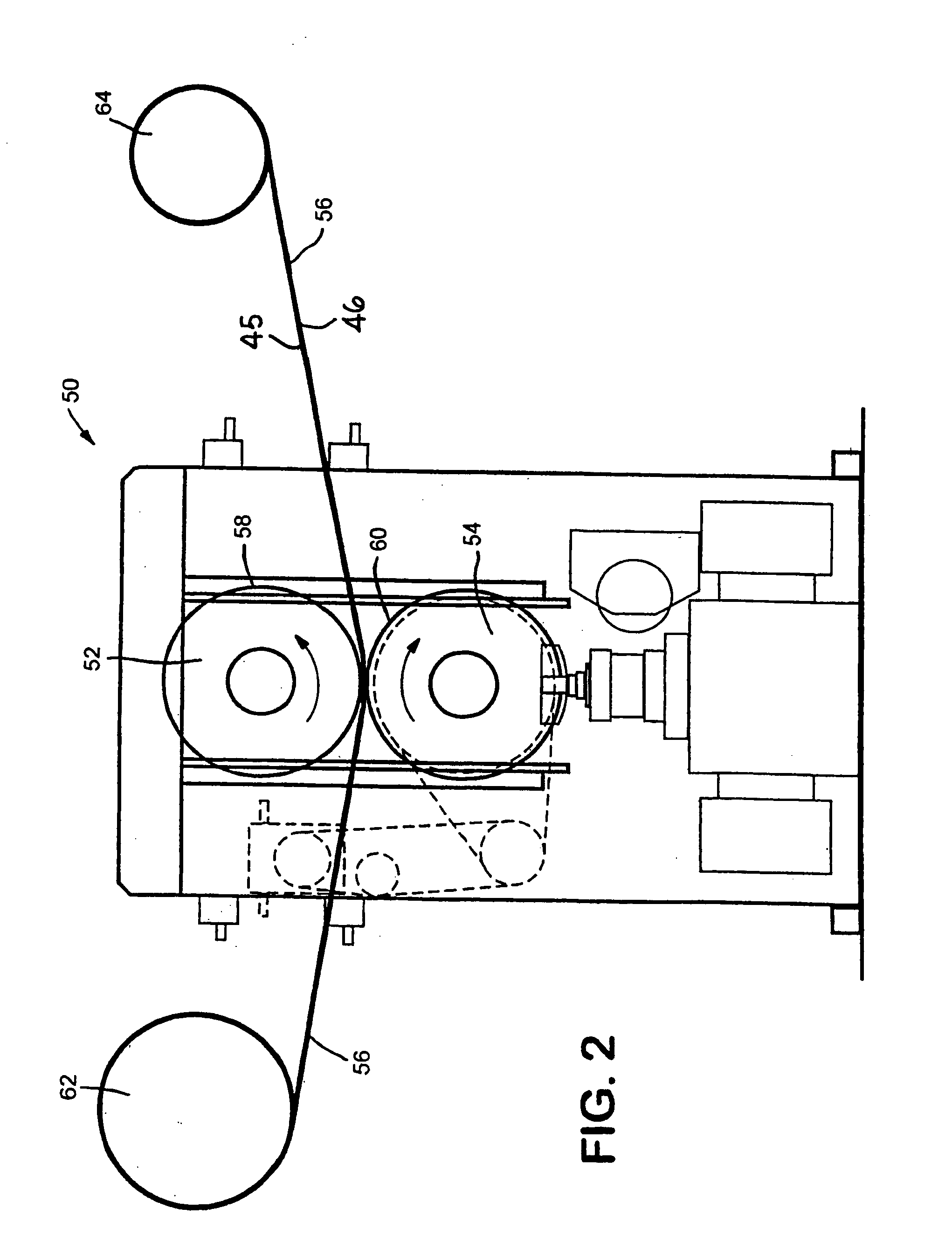Rolled paper product having high bulk and softness
a technology of rolled paper and softness, applied in the field of paper product manufacturing, can solve the problems of loss of softness, reducing the fuzzy surface of tissue, and not being perceived as so
- Summary
- Abstract
- Description
- Claims
- Application Information
AI Technical Summary
Benefits of technology
Problems solved by technology
Method used
Image
Examples
example 1
[0125] A single-ply, three-layered uncreped throughdried bath tissue was made using eucalyptus fibers for the outer layers and softwood fibers for the inner layer. Prior to pulping, a quaternary ammonium softening agent (PROSOFT TQ1003 sold by Hercules Incorporated) was added at a dosage of 4.1 kg / Mton of active chemical per metric ton of fiber to the eucalyptus furnish. After allowing 20 minutes of mixing time, the slurry was dewatered using a belt press to approximately 32 percent consistency. The filtrate from the dewatering process was either sewered or used as pulper make-up water for subsequent fiber batches but not sent forward in the stock preparation or tissuemaking process. The thickened pulp containing the debonder was subsequently re-dispersed in water and used as the outer layer furnishes in the tissue-making process.
[0126] The softwood fibers were pulped for 30 minutes at 4 percent consistency and diluted to 3.2 percent consistency after pulping, while the debonded eu...
example 2
[0133] Example 2 was produced as Example 1, and the shear calender device was operated at a 0.003 inch gap. The lower polyurethane roll was run at a speed 10 percent faster than the upper polyurethane roll, which was running 500 fpm. The web was then run through the UFD process prior to being wound into a tissue roll.
[0134] To wind the tissue, the winder was set at 120 mm diameter, 227 sheet count, and 104 mm sheet length. The finished product diameter measured 116 mm. The roll had a roll bulk of 11.7 cc / g and a Fuzz-On-Edge of 2.4 mm / mm for the fabric side of the web having the topically applied polysiloxane formulation. The roll had a Kershaw roll firmness of 10.6 mm. The tissue had a CD Kawabata Bending Stiffness of 0.030 gram-force cm2 / cm. The tissue had a Wet Out Time of 5.8 seconds.
example 3
[0135] Example 3 was produced as Example 1, except that the shear calender device was operated at a 0.004 inch gap. The lower polyurethane roll was run at a speed 10 percent faster than the upper polyurethane roll, which was running 500 fpm. The web was then run through the UFD process prior to being wound into a tissue roll.
[0136] To wind the tissue, the winder was set at 123 mm diameter, 190 sheet count, and 104 mm sheet length. The finished product diameter measured 121 mm. The roll had a roll bulk of 15.5 cc / g and a Fuzz-On-Edge of 1.8 mm / mm for the fabric side of the web having the topically applied polysiloxane formulation. The roll had a Kershaw roll firmness of 11.5 mm. The tissue had a CD Kawabata Bending Stiffness of 0.045 gram-force cm 2 / cm. The tissue had a Wet Out Time of 4.0 seconds.
Control 1
[0137] A parent roll of tissue as made above was then converted using standard techniques, specifically, a single conventional polyurethane / steel calender instead of the shear c...
PUM
| Property | Measurement | Unit |
|---|---|---|
| Length | aaaaa | aaaaa |
| Length | aaaaa | aaaaa |
| Dimensionless property | aaaaa | aaaaa |
Abstract
Description
Claims
Application Information
 Login to View More
Login to View More - R&D
- Intellectual Property
- Life Sciences
- Materials
- Tech Scout
- Unparalleled Data Quality
- Higher Quality Content
- 60% Fewer Hallucinations
Browse by: Latest US Patents, China's latest patents, Technical Efficacy Thesaurus, Application Domain, Technology Topic, Popular Technical Reports.
© 2025 PatSnap. All rights reserved.Legal|Privacy policy|Modern Slavery Act Transparency Statement|Sitemap|About US| Contact US: help@patsnap.com



